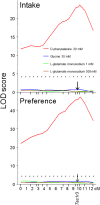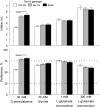Genetics of Amino Acid Taste and Appetite
- PMID: 27422518
- PMCID: PMC4942865
- DOI: 10.3945/an.115.011270
Genetics of Amino Acid Taste and Appetite
Abstract
The consumption of amino acids by animals is controlled by both oral and postoral mechanisms. We used a genetic approach to investigate these mechanisms. Our studies have shown that inbred mouse strains differ in voluntary amino acid consumption, and these differences depend on sensory and nutritive properties of amino acids. Like humans, mice perceive some amino acids as having a sweet (sucrose-like) taste and others as having an umami (glutamate-like) taste. Mouse strain differences in the consumption of some sweet-tasting amino acids (d-phenylalanine, d-tryptophan, and l-proline) are associated with polymorphisms of a taste receptor, type 1, member 3 gene (Tas1r3), and involve differential peripheral taste responsiveness. Strain differences in the consumption of some other sweet-tasting amino acids (glycine, l-alanine, l-glutamine, and l-threonine) do not depend on Tas1r3 polymorphisms and so must be due to allelic variation in other, as yet unknown, genes involved in sweet taste. Strain differences in the consumption of l-glutamate may depend on postingestive rather than taste mechanisms. Thus, genes and physiologic mechanisms responsible for strain differences in the consumption of each amino acid depend on the nature of its taste and postingestive properties. Overall, mouse strain differences in amino acid taste and appetite have a complex genetic architecture. In addition to the Tas1r3 gene, these differences depend on other genes likely involved in determining the taste and postingestive effects of amino acids. The identification of these genes may lead to the discovery of novel mechanisms that regulate amino acid taste and appetite.
Keywords: behavior; consumption; gustatory nerves; inbred strain; intake; mouse; preference; sweet; umami.
© 2016 American Society for Nutrition.
Conflict of interest statement
Author disclosures: AA Bachmanov, NP Bosak, JI Glendinning, M Inoue, X Li, S Manita, SA McCaughey, Y Murata, DR Reed, MG Tordoff, GK Beauchamp, no conflicts of interest.
Figures











References
-
- Sclafani A. Macronutrient-conditioned flavor preferences. In: Berthoud HR, Seeley RJ, editors. Neural and metabolic control of macronutrient intake. Boca Raton (FL): CRC Press; 1999. p. 93–107.
-
- Fromentin G, Darcel N, Chaumontet C, Marsset-Baglieri A, Nadkarni N, Tome D. Peripheral and central mechanisms involved in the control of food intake by dietary amino acids and proteins. Nutr Res Rev 2012;25:29–39. - PubMed
-
- Ackroff K, Kondoh T, Sclafani A. Dried bonito dashi: a preferred fish broth without postoral reward actions in mice. Chem Senses 2014;39:159–66. - PubMed
-
- Ackroff K, Sclafani A. Flavor preferences conditioned by intragastric monosodium glutamate in mice. Chem Senses 2013;38:759–67. - PubMed
-
- Uematsu A, Tsurugizawa T, Kondoh T, Torii K. Conditioned flavor preference learning by intragastric administration of L-glutamate in rats. Neurosci Lett 2009;451:190–3. - PubMed
Publication types
MeSH terms
Substances
Grants and funding
LinkOut - more resources
Full Text Sources
Other Literature Sources
Molecular Biology Databases

